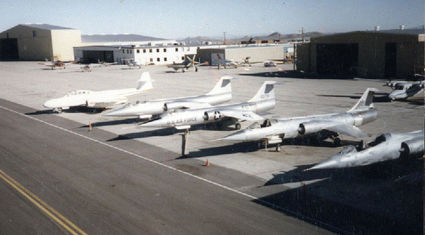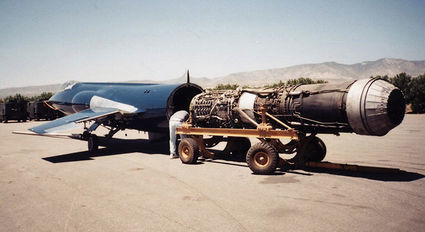Lockheed F-104 and the GE J-79 Jet engine that powered it
Short Flights
My husband Al and I review our old photos on a regular basis and are always happy to see the pictures that jar our memories into remembering the exciting projects we have worked on in years gone by.
This photo (below) shows Al installing the General Electric J-79 engine into a Lockheed F-104 Starfighter that he was hoping to build into a flyer. Ever since he watched Darryl Greenamyer set the absolute speed record in October 1977 at Mud Lake, Tonopah, Nevada, with the "Red Baron," Al decided that he too should build up an F-104.
He worked on his treasure for years with the full intention of flying the sleek mach-two fighter. Around eight years later, he mentioned to another friend how his F-104 would make a great static display for a museum, but was met with scoffs and the friend saying, "No one wants to see an old Starfighter just sitting around."
Not one week went by when that friend called and said, "We have a trade with the Air Force Museum and you have to have that airplane ready to ship to Merced for the Castle AFB Air Museum!" Apparently the USAF Museum had a "Heritage Program" for old jet fighters and they could place as many F-104s as we could put together.
Al contacted Darryl and told him what was happening and before you knew it the three guys were partners building up F-104s for museums around the country. Darryl remembered where other fuselages were located, plus wings, gears, etc. A total of six Starfighters were made into static displays and trucked to new homes.
The first Starfighter delivered by Al and his partners was an F-104B (two-place) to Castle AFB Museum in Merced-Atwater. The F-104B and -D models were combat-capable two-place trainer versions. There were 26 two-place B-Models built and 21 D-Models produced. The wingspan was just under 22-feet and the aircraft length was just over 54-feet. It was powered by one General Electric J-79 with 15,800 pounds of thrust, with afterburner. The maximum speed was 1,320 mph (Mach 2.)
The J-79 was very impressive in the early 1950s. The J79's first flight took place in Schenectady, New York in 1955. The J79 was placed in a bomb bay of a J47-powered B-45 Tornado. The engine was tested by lowering it from the bomb bay into the air stream. The four J47s were shut down and the J79 powered the B-45.
In the early 1950s, the U.S. military established a requirement for a high thrust, low weight, mechanically simple jet engine that could perform efficiently at Mach 0.9 cruise and Mach 2.0 combat speeds.
The J79 powered several production aircraft: Convair B-58 Hustler; Lockheed F-104 Starfighter; McDonnell F-4 Phantom II; and North American RA-5 Vigilante. The 1958 Collier Trophy was awarded to the Air Force, Lockheed, and GE team that developed the F-104 fighter, the world's first Mach 2 operational fighter. A civil variant of the J-79 was used on the Convair 880 series of airliners and a civil turbofan variant powered the Convair 990.
This engine is just over seventeen feet long, and slightly more than three feet in diameter and weighs around 3,600 pounds. Fuel consumption on the J-79 Turbine Engine that powers the F104 Starfighter is impressive! It burns 10 gallons per second at full afterburner, which calculates out to 600 gallons of fuel in one minute!
We had a production line of F-104s in a row along the flightline at Mojave Airport in 1986. (In the photo above, the aircraft at the far end was Al Letcher's Gloster Meteor.) Everyone would tease Al about his air force. Another F-104 went to Grass Valley Airport for a tribute to Gen. Chuck Yeager who lives below the end of runway 25.
I have a scar on my face to remember the Starfighter that sits on the pedestal at Wright-Patterson AFB in Dayton, Ohio. I was helping Al push the aft-section onto the support pipe that was fitted inside the 104 when the chain that was holding the 500-pound stainless steel tail section fell off of the fork of the forklift onto me. It hit my forehead and cut into my cheek, which at the time we didn't realize. Ken Coffee was standing nearby watching and grabbed me as I was falling to the ground. Thanks Ken!
Whenever I think of that F-104 Starfighter on the pedestal at the Air Force Museum in Dayton, I always remember the day Al dropped that airplane on me and branded me (so to speak!) I used to think about getting the scar removed, but now it doesn't bother me. All the wrinkles cover it up anyway.
See you on our next flight!






